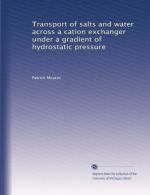|
This section contains 344 words (approx. 2 pages at 300 words per page) |
Hydrostatic pressure is a state of stress characterized by equal principal stresses, S1 = S2 = S3. This is the state of stress that exists at any point in a liquid at rest. Units of measurement are pounds per square inch (psi) in the English System and megabars (Mb) in the International System. The concept of hydrostatic pressure or stress is very important to many disciplines of physical science and engineering. Geologists often consider pore fluid pressure in rocks as hydrostatic, as if the fluid is part of a column of water open to the surface. Well drilling engineers must know whether the pore fluid pressure at depth is normal hydrostatic, overpressured, or underpressured to design the fluid system used to drill the wells. A correct design minimizes the dangers of blowout or formation damage. The mechanical behavior of rocks depends, in part, on the hydrostatic pressure (also called confining pressure or mean stress) part of the total stress (the sum of the mean stress and shear stresses) acting on the rock. In general, brittle rock strength increases with increase in hydrostatic stress.
Hydrostatic pressure is a scalar quantity because it does not vary with direction. The magnitude of hydrostatic pressure P at any point in a liquid is determined by the height of the column of liquid above the point and the density of the liquid. Hydrostatic pressure P varies with depth according to the linear relationship, P = ρgh, where ρ is the fluid density, g is the gravitational constant, and h is the depth of the column of fluid to the measured point. If water is the fluid, the hydrostatic pressure gradient is: P = ρgh = 0.4 psi/foot (9.8 kPa/m). The state of stress in liquids is hydrostatic because fluids do not support any shear stress (any differences among the principal stresses). In general, the stress state in rocks of the upper crust is not hydrostatic because solids support shear stress. Many petroleum engineers assume the state of stress at depth in the earth is hydrostatic to simplify their calculations.
See Also
|
This section contains 344 words (approx. 2 pages at 300 words per page) |


